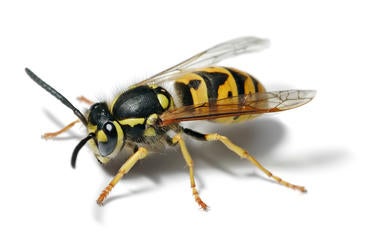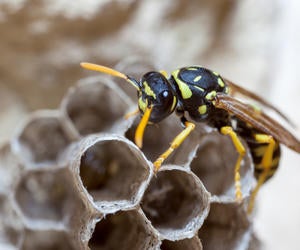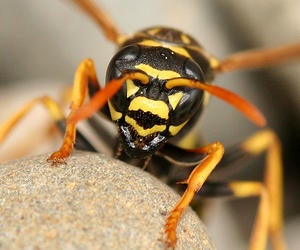UC Riverside Southern California Yellowjacket Wasp Survey
This page was created in February 2003 and was valid ONLY UNTIL DECEMBER 2004.
What we are doing
We are researching the distribution of yellowjackets in southern California. The two most pestiferous species in the Los Angeles Basin are the native, western yellowjacket, Vespula pensylvanica and the non-native German yellowjacket, Vespula germanica. (please see Yellowjacket Identification for a more extensive discussion of southern California yellowjackets and a very simple key on how to identify them). One of the biggest problems in dealing with yellowjackets is that there are species differences in food preferences, attractants, possibly peak time of activity during the year, etc. All these factors play a role in trying to determine the best control methods for eliminating them or reducing their populations.
Besides being a nuisance, yellowjackets are a medical threat, especially to hypersensitive people and they can seriously impact revenues at outdoor faciilties which serve food.
Why we want your help
Because there are distinct differences between the western and German yellowjackets, we need to know where they are found to maximize control efforts otherwise we might be targeting the wrong species or the wrong area. Therefore, one major part of our research is to determine where the two species live in southern California. We are seeking the help of as many people as possible, hoping that many folks will submit yellowjackets to us for identification from all over southern California in order to produce a reliable distribution map.
What we do want
Before telling you what we need, first you must realize what a yellowjacket is because people often mistake paper wasps for yellowjackets. See Yellowjacket Identification for a more indepth discussion of yellowjackets and non-yellowjackets.
At the left is a yellowjacket wasp. This one is Vespula germanica, but all our species are fairly similar to this.
Yellowjackets make nests underground or behind walls (some species in the mountainous areas make hanging nests surrounded by a paper carton).
We are interested in wasps from anywhere in southern California. In the future we may extend to other parts of California, but for now, we are concentrating on the counties of San Diego, Riverside, San Bernardino, Orange, Los Angeles, and Ventura.
What we don't want
These are paper wasps, or Polistes sp. they are NOT yellowjackets, and we do not want paper wasps for our study so please do not send them.
Paper wasps make umbrella-shaped nests in which the comb is visible, often under the eaves of homes. Yellowjacket nests have paper carton surrounding the nest, and mostly are found in holes in the ground or in cavities in buildings.
We also do not need wasps from other areas of the country, or other areas of California.
Please only send us yellowjackets. Do not send other insects because you are curious what they are. Because of the severe state budget constraints now and for the next few years, we only have time to work on yellowjacket issues. Additionally, we don't know other insects as well so we probably couldn't identify them anyway.
How to collect yellowjackets
If you are able and willing to send us yellowjackets (even only one from your home will be welcomed), please do. However, if you do not want to take the risk of being stung, please do not participate in the collecting. You should kill the yellowjacket with minimal risk to yourself and you should only go after single wasps that are flying around (not nests). Use a fly swatter and smack the wasp or catch it in an insect net and then kill it. Putting the wasp in the freezer for 24 hrs or dropping it into rubbing alcohol will ensure that it will not recover and sting you. (Be careful because merely stunned wasps may still sting by reflex and some may recover later (not a pleasant experience for either of you). The wasp does not have to be in perfect condition but the head needs to be attached to the body for ID.
Do not try to collect wasps from nests unless you know what you are doing because you are at risk to be stung multiple times but if a pest control company does exterminate a nest on your property and you can find a dead wasp on the ground afterward, we would appreciate it. If you have any doubts about your ability to safely collect a wasp, do not participate. We do not want anyone getting nailed by these beasts in attempting to help us.
Send the wasp(s) to us in a small box or padded envelope. Do not just place them in a small baggie in a regular envelope. People have done this and the insect gets pulverized into dust on its journey to UC Riverside. Also, if you use rubbing alcohol as the killing agent, remove the wasp from the alcohol first before mailing. DO NOT MAIL alcohol as this is a serious postal violation (i.e., sending flammable liquids through the mail). One final comment: Please only send us insects that you believe are yellowjackets.
Information to send
We will need to know the date the wasp was collected and where, as precisely as we can.
We are hoping to have enough yellowjackets submitted so that we can predict where they can be found. Therefore, we will need more information than just the city of collection (for example, in Anaheim, the German yellowjacket is very common in the parks in the flatlands however, western yellowjackets are very common around the Anaheim hills. Therefore, a distance of 1 mile may make a difference. Stating "Anaheim" will not be a sufficiently fine-grain location indicator.)
Please tell us the address, and/or a nearby intersection.
Where to send them
This link will bring up a submission form in Adobe Acrobat Reader (pdf) format. To send a wasp, print this out, fill it in, and send it with your wasp. If you have problems with the pdf document, this link is to a Microsoft Word Rich Text Format version. (Please note that the link was disabled)



